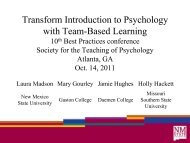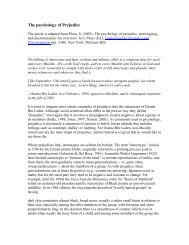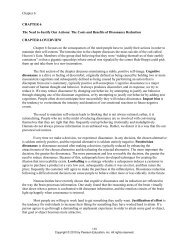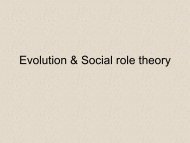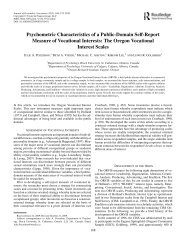Attitudes and Attitude Change CHAPTER 7 Attitudes and Attitude ...
Attitudes and Attitude Change CHAPTER 7 Attitudes and Attitude ...
Attitudes and Attitude Change CHAPTER 7 Attitudes and Attitude ...
Create successful ePaper yourself
Turn your PDF publications into a flip-book with our unique Google optimized e-Paper software.
172<br />
Copyright © 2010 by Pearson Education, inc. All rights reserved.<br />
<strong><strong>Attitude</strong>s</strong> <strong>and</strong> <strong>Attitude</strong> <strong>Change</strong><br />
• LaPiere did a classic field study in the 1930s, where he found that hotel <strong>and</strong> restaurants served a Chinese<br />
couple despite their written statements that they would not do so.<br />
• Later research reveals that attitudes do predict behavior, but only under certain conditions.<br />
A. Predicting Spontaneous Behaviors<br />
• People’s attitudes will predict/be consistent with their spontaneous behaviors when the attitudes are<br />
highly accessible. <strong>Attitude</strong> accessibility refers to the strength of the association between an attitude<br />
object <strong>and</strong> a person’s evaluation of that object, measured by the speed with which people can report<br />
how they feel about the object. If the attitudes are not highly accessible, arbitrary aspects of the<br />
situation will tend to determine behavior.<br />
B. Predicting Deliberative Behaviors<br />
• Ajzen <strong>and</strong> Fishbein’s theory of planned behavior is a theory of how attitudes predict planned,<br />
deliberative behavior; according to this theory the best predictors of these behaviors are the person’s<br />
specific attitudes, his or her subjective norms, <strong>and</strong> their perceived behavioral control (Figure 7.7, p.<br />
213).<br />
1. Specific <strong><strong>Attitude</strong>s</strong><br />
• The attitude that is important is not a general attitude but their attitude towards the specific<br />
behavior in question. For example, Davidson <strong>and</strong> Jaccard (1979) showed that married women’s<br />
use of birth control pills was much better predicted by their attitude towards using the pills during<br />
the next two years than it was by their attitudes towards the pills or towards birth control (Table<br />
7.1, p. 213).<br />
2. Subjective norms<br />
• People’s beliefs about how those they care about will view the behavior in question. Asking<br />
people about their subjective norms increases the ability to predict planned, deliberative<br />
behaviors.<br />
3. Perceived behavioral control<br />
• The ease with which people believe they can perform the behavior. If people think it is easy to<br />
perform the behavior, they are more likely to form a strong intention to do it.<br />
• Considerable research supports the idea that asking people about these three determinants of<br />
their intentions increases the ability to predict their planned, deliberative behaviors.<br />
V. The Power of Advertising<br />
• Wilson <strong>and</strong> Brekke (1994) found that most people think advertising works on everybody but<br />
themselves.<br />
• Contrary to such beliefs, the evidence indicates that advertising works, in the sense that sales increase.<br />
• The best evidence that advertising works comes from studies using split cable market tests, where<br />
advertisers work in conjunction with cable companies <strong>and</strong> stores to show ads to a r<strong>and</strong>omly selected<br />
group of people <strong>and</strong> see whether these people are more likely to buy the product.<br />
• Ads work particularly well for new products.<br />
A. How Advertising Works<br />
• Advertisers should consider the kind of attitude they are trying to change. If they are trying to<br />
change an affectively based attitude, it is best to take an emotional approach (e.g., associate feelings<br />
of excitement, energy, <strong>and</strong> sexual attractiveness with the br<strong>and</strong>). If they are trying to change a<br />
cognitively based attitude, they also need to consider the personal relevance of the attitude.<br />
• If a product is personally relevant, the best way to change it is through strong arguments; if a<br />
product is not personally relevant, advertising may attempt to make it seem so (e.g., Gerald Lambert<br />
created the term “halitosis” to increase sales for Listerine).






